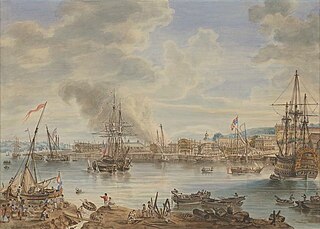 W
WChatham Dockyard was a Royal Navy Dockyard located on the River Medway in Kent. Established in Chatham in the mid-16th century, the dockyard subsequently expanded into neighbouring Gillingham.
 W
WConvoys Wharf, formerly called the King's Yard, is the site of Deptford Dockyard, the first of the Royal Dockyards, built on a riverside site in Deptford, by the River Thames in London, England. It was first developed in 1513 by Henry VIII to build vessels for the Royal Navy. Convoys Wharf also covers most of the site of Sayes Court manor house and gardens, home of diarist John Evelyn.
 W
WDeptford Dockyard was an important naval dockyard and base at Deptford on the River Thames, operated by the Royal Navy from the sixteenth to the nineteenth centuries. It built and maintained warships for 350 years, and many significant events and ships have been associated with it.
 W
WDeptford Wharf in London, UK is situated on the Thames Path southeast of South Dock Marina, across the culverted mouth of the Earl's Sluice and north of Aragon Tower. The housing here, completed in 1992, is on the site of former railway sidings and riverside wharves, and before then docks and building slips.
 W
WHer Majesty's Naval Base, Devonport is one of three operating bases in the United Kingdom for the Royal Navy and is the sole nuclear repair and refuelling facility for the Royal Navy. The largest naval base in Western Europe, HMNB Devonport is located in Devonport, in the west of the city of Plymouth, England.
 W
WFrindsbury, sometimes called Frinsbury, is part of the Medway Towns conurbation in Kent, southern England. It lies on the opposite side of the River Medway to Rochester, and at various times in its history has been considered fully or partially part of the City of Rochester. Frindsbury refers to both a parish and a manor. Within the civil parish of Frindsbury Extra are the villages of Frindsbury, Wainscott, and Upnor. Frindsbury was also the name given to an electoral ward in the City of Rochester that straddled the parishes of Frindsbury and Strood.
 W
WHarwich Dockyard was a Royal Navy Dockyard at Harwich in Essex, active in the 17th and early 18th century. Owing to its position on the East Coast of England, the yard was of strategic importance during the Anglo-Dutch Wars; however, due to a lack of deep-water access and the difficulty of setting off from Harwich against an easterly wind, its usefulness was somewhat limited and its facilities remained small-scale compared to the other Royal Dockyards over the same period. Nonetheless, it remained actively involved in repairing and refitting the nation's warships, as well as building them: of the eighty ships built for the Royal Navy in Britain between 1660 and 1688, fourteen were built at Harwich Dockyard..
 W
WMylor Creek is a tidal ria in south Cornwall, United Kingdom. It is a tributary of Carrick Roads, the estuary of the River Fal and is situated approximately six miles (10 km) south of Truro and two miles (3 km) north of Falmouth .
 W
WHer Majesty's Naval Base, Portsmouth is one of three operating bases in the United Kingdom for the Royal Navy. Portsmouth Naval Base is part of the city of Portsmouth; it is located on the eastern shore of Portsmouth Harbour, north of the Solent and the Isle of Wight. Until the early 1970s, it was officially known as Portsmouth Royal Dockyard ; thereafter the term 'Naval Base' gained currency, acknowledging a greater focus on personnel and support elements alongside the traditional emphasis on building, repairing and maintaining ships. In 1984 Portsmouth's Royal Dockyard function was downgraded and it was formally renamed the 'Fleet Maintenance and Repair Organisation' (FMRO). The FMRO was privatized in 1998, and for a time, shipbuilding, in the form of block construction, returned. Around the year 2000, the designation HMS Nelson was extended to cover the entire base.
 W
WRoyal Navy Dockyards were state-owned harbour facilities where ships of the Royal Navy were built, based, repaired and refitted. Until the mid-19th century the Royal Dockyards were the largest industrial complexes in Britain.
 W
WSheerness Dockyard also known as the Sheerness Station was a Royal Navy Dockyard located on the Sheerness peninsula, at the mouth of the River Medway in Kent. It was opened in the 1660s and closed in 1960.
 W
WWoolwich Dockyard was an English naval dockyard along the river Thames at Woolwich in north-west Kent, where many ships were built from the early 16th century until the late 19th century. William Camden called it 'the Mother Dock of all England'. By virtue of the size and quantity of vessels built there, Woolwich Dockyard is described as having been 'among the most important shipyards of seventeenth-century Europe'. During the Age of Sail, the yard continued to be used for shipbuilding and repair work more or less consistently; in the 1830s a specialist factory within the dockyard oversaw the introduction of steam power for ships of the Royal Navy. At its largest extent it filled a 56-acre site north of Woolwich Church Street, between Warspite Road and New Ferry Approach; 19th-century naval vessels were fast outgrowing the yard, however, and it eventually closed in 1869. The former dockyard area is now partly residential, partly industrial, with remnants of its historic past having been restored.